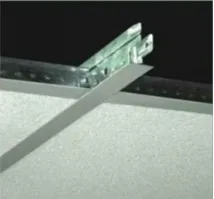10 月 . 17, 2024 13:05 Back to list
mineral fibre board ceiling vs gypsum board
Mineral Fibre Board Ceiling vs. Gypsum Board A Comprehensive Comparison
When it comes to interior construction and design, selecting the right ceiling material is crucial. Among the most popular options are mineral fibre boards and gypsum boards, each with unique properties, benefits, and applications. This article will explore both materials in detail, focusing on their characteristics, advantages, disadvantages, and suitability for various environments.
Mineral Fibre Board
Mineral fibre boards, often referred to as acoustic ceiling tiles, are made from a combination of natural and synthetic fibers, predominantly mineral wool. They are praised for their effective sound absorption qualities and thermal insulation properties. Their porous structure allows them to trap sound, making them a preferred choice for spaces where noise control is essential, such as offices, restaurants, and schools.
Advantages of Mineral Fibre Boards
1. Acoustic Performance One of the primary benefits of mineral fibre boards is their outstanding sound absorption capability. With a Noise Reduction Coefficient (NRC) ranging from 0.6 to 0.9, they can significantly reduce noise levels in a room, enhancing the auditory experience.
2. Fire Resistance Mineral fibre boards are typically non-combustible, offering a level of fire resistance that can be advantageous in commercial buildings. They can help slow the spread of flames, contributing to overall safety.
3. Thermal Insulation The fibrous nature of mineral wool provides good thermal insulation, helping to keep spaces warm in winter and cool in summer.
4. Lightweight and Easy to Install Mineral fibre tiles are lightweight, making them easier to handle and install on a T-bar ceiling grid.
5. Variety of Styles Available in various textures, designs, and sizes, these boards can cater to different aesthetic preferences while providing functional benefits.
Disadvantages of Mineral Fibre Boards
1. Moisture Sensitivity Mineral fibre boards can be susceptible to water damage, which may lead to sagging or mold growth. They are not suitable for high-humidity areas, such as bathrooms or pools, without special treatment.
2. Durability Concerns Although lightweight, they can be prone to surface damage and are not as durable as other ceiling materials. Scratches and dents can compromise their appearance.
Gypsum Board
mineral fibre board ceiling vs gypsum board

Gypsum board, also known as drywall, consists of a gypsum core sandwiched between two layers of paper. It is one of the most commonly used materials for wall and ceiling construction in residential and commercial buildings. Gypsum boards are valued for their smooth finish, versatility, and cost-effectiveness.
Advantages of Gypsum Boards
1. Fire Resistance Gypsum is naturally fire-resistant; therefore, it provides a good level of fire protection. Fire-rated gypsum boards are commonly used in applications requiring enhanced safety.
2. Moisture and Mold Resistance Certain types of gypsum boards are specifically designed to be moisture-resistant, making them suitable for high-humidity environments. They help inhibit mold growth, which is essential for maintaining healthy indoor air quality.
3. Easy to Finish Gypsum boards offer a smooth surface that can be painted or textured easily, allowing for various aesthetic applications.
4. Durability With proper care, gypsum boards can withstand impacts better than mineral fibre boards, resulting in a more durable ceiling solution.
5. Sustainability Many gypsum boards are manufactured from recycled materials and can themselves be recycled, making them an environmentally friendly option.
Disadvantages of Gypsum Boards
1. Acoustic Limitations While gypsum boards can provide some sound dampening, they do not perform as well as mineral fibre boards in reducing noise levels.
2. Weight Gypsum boards tend to be heavier, which can make installation more challenging and may require additional structural support.
Conclusion
Choosing between mineral fibre board ceilings and gypsum board ultimately depends on the specific needs of a project. If superior acoustic performance, lightweight construction, and thermal insulation are priorities, mineral fibre boards are likely the better choice. However, if fire resistance, moisture control, and surface durability are of greater importance, gypsum boards might be the preferred option.
Both materials have their own set of advantages and disadvantages, and understanding the requirements of the space, budget, and aesthetic preferences will guide you to the right decision for your ceiling project.
-
Revolutionizing Interior Design with Ceilings t grid Suspended SystemNewsOct.29,2024
-
Revolutionizing Ceiling Design with ceiling access panel with Gypsum Tile WaterproofNewsOct.29,2024
-
Revolutionizing Interior Design with PVC Gypsum Ceiling: A Comprehensive GuideNewsOct.29,2024
-
Elevating Interior Design with High quality Mineral Fiber Ceiling TilesNewsOct.29,2024
-
Revolutionizing Interior Design with PVC Gypsum Ceiling: A Comprehensive GuideNewsOct.29,2024
-
Elevating Interior Design with High-Quality Mineral Fiber Ceiling Tiles: A Comprehensive GuideNewsOct.29,2024







